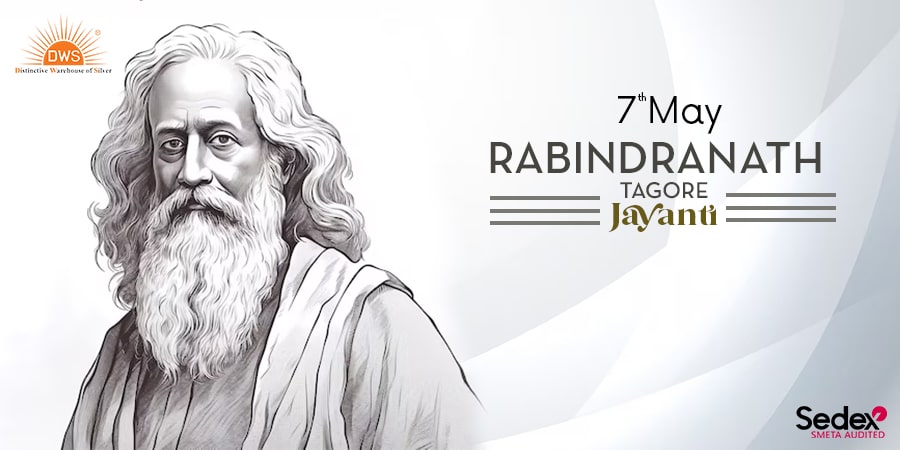- Written By Team DWS
- Festivals
- April 26, 2025
Celebrating the Legacy: Rabindranath Tagore's Birthday and His Timeless Influence
Each year, the 7th of May holds a special significance for not only the people of India but also the world at large. Today, we honor the birth of Rabindranath Tagore, an eminent luminary in the realms of literature, music, art, and philosophy. Tagore was born in 1861 in Kolkata, then known as Calcutta, into a culturally rich family that nurtured his artistic inclinations from a young age. Today, as we honor the legacy of this luminary on his birthday, it is essential to reflect on how his profound contributions continue to resonate with audiences across generations and cultures.

A Multifaceted Genius
Tagore was not merely a poet; he was a polymath. He penned over 2,000 songs, wrote countless poems, and authored numerous plays and novels. His acclaimed masterpiece, Gitanjali: Song Offerings, earned him the Nobel Prize in Literature in 1913, making him the first non-European recipient of this honor. The universe of Tagore's literature is vast, characterized by themes of love, nature, humanity, and an unquenchable thirst for freedom. His poignant verses invite readers to traverse the intricate landscapes of human emotions and the natural world, creating a timeless dialogue between the individual and society.
Tagore's literary prowess extended to music and art. He composed many songs that are anthems of cultural pride and emotional depth, reflecting the ethos of his era. The national anthem of India, "Jana Gana Mana," and Bangladesh, "Amar Sonar Bangla," reflect his profound impact, illustrating how his artistic genius crossed boundaries and inspired entire nations.
A Visionary Humanist
Beyond his artistic genius, Tagore was also a social reformer. He believed in education as a means to empower individuals and transform society. In 1901, he founded Visva-Bharati University at Shantiniketan, which embodied the essence of his comprehensive education, integrating both scholarly and creative endeavours. Tagore envisaged a space where people could learn through experience, connection with nature, and creative expression, celebrating the manifold ways in which knowledge can be acquired and shared.
His philosophy was deeply rooted in humanism. He emphasized the interconnectedness of all beings and advocated for a world in which identities are not constrained by borders or cultural divisions. In his essay "The Nation" (1917), Tagore critiqued narrow nationalism and called for a broader vision of humanity, advocating for mutual respect and understanding. In an age where conflicts often arise from restrictive identities, his teachings on universal brotherhood and peace remain profoundly relevant.
The Reverberation of Tagore's Influence
The influence of Rabindranath Tagore transcends time and geography, touching hearts and minds far beyond the subcontinent. His works have been extensively translated into numerous languages, allowing them to reach diverse audiences. Tagore's ability to connect with universal themes of love, loss, and longing ensures that readers from different cultural backgrounds can find resonance in his narratives.
His effect on literature and the arts has spurred global movements, inspiring numerous poets, writers, and musicians. Figures like W.B. Yeats, Franz Kafka, and Pablo Neruda have lauded Tagore's genius, recognizing him as a beacon of inspiration. His profound understanding of human emotions invites artists across disciplines to engage with their own contexts while remaining rooted in shared human experiences.
Moreover, Tagore's influence permeates the realm of social thought. His ideas about education, society, and the importance of cultural exchange echo in contemporary discussions around systemic change and social justice. Educators and reformers continue to reference his philosophies, striving to create inclusive spaces that celebrate creativity, critical thinking, and emotional intelligence.
Celebrating Tagore Today
As we celebrate Tagore's birthday, a myriad of events unfold globally, from poetry readings and musical performances to art exhibitions inspired by his diverse works. These celebrations forge connections between the past and the present, allowing us to revisit his messages through modern lenses and revealing the ongoing relevance of his thoughts.
In schools and communities, educators often use Tagore’s writings to instill love for language and literature among students—teaching them to appreciate the beauty of expression while fostering critical thinking. Contemporary artists create new interpretations of his songs and poems, breathing fresh life into his immortal lines while ensuring that his legacy continues to evolve.
Conclusion
Rabindranath Tagore's birthday is more than merely a date on the calendar; it is an invitation to reflect on his enduring impact and an opportunity to engage with the ideals he championed. His legacy teaches us the importance of creativity, compassion, and global interconnectedness. As we celebrate the life and work of this extraordinary figure, let us carry forward his messages of unity, love, and the transformational power of art, inspiring future generations to cultivate a world enriched by understanding, creativity, and a shared humanity. Through our actions and expressions, we can honor Tagore's vision of a harmonious existence, reminding ourselves that art and culture have the profound ability to bridge divides and elevate the human spirit.

FAQs on the Birthday of Rabindranath Tagore
Certainly! Here are some frequently asked questions (FAQs) about the birthday of Rabindranath Tagore:
Q1: When is Rabindranath Tagore's birthday celebrated?
A1: Rabindranath Tagore's birthday is celebrated on May 7th every year.
Q2: Why is Rabindranath Tagore significant?
A2: Rabindranath Tagore was a renowned Indian poet, novelist, musician, and painter. He is the first non-European to win the Nobel Prize in Literature in 1913 for his work "Gitanjali." He is celebrated for his contributions to literature, art, and music, and for his role in the Indian independence movement.
Q3: How is Tagore's birthday celebrated in India and around the world?
A3: Tagore's birthday is celebrated with various cultural programs, including poetry readings, musical performances, dance, and discussions on his works. Educational institutions often organize events to honor him, and many people recite his poems and songs. In West Bengal, it is a public holiday.
Q4: What are some famous works of Rabindranath Tagore?
A4: Some of his famous works include "Gitanjali," "Chokher Bali," "The Home and the World," "Kabuliwala," and numerous songs known as Rabindra Sangeet.
Q5: What is the significance of "Gitanjali"?
A5: "Gitanjali," which translates to "Song Offerings," is a collection of poems that convey Tagore's deep spirituality and exploration of the divine. This work played a significant role in earning Tagore the Nobel Prize and is considered a masterpiece of literature.
Q6: Did Rabindranath Tagore have any influence on Indian music?
A6: Yes, Tagore is known for his significant contributions to music. He composed thousands of songs known as Rabindra Sangeet, which are an integral part of Bengali culture. His music often reflects his literary themes and emotional depth.
Q7: Are there any memorials or museums dedicated to Tagore?
A7: Yes, there are several memorials and museums dedicated to Rabindranath Tagore, including the Tagore Museum in Jorasanko, Kolkata, and Visva-Bharati University in Santiniketan, which he founded. These places preserve his legacy and promote his works.
Q8: Is there a specific event or ceremony held on his birthday?
A8: Many institutions hold special ceremonies that include the singing of Tagore's songs, recitations of his poems, and discussions about his life and contributions. In some places, a traditional ceremony known as "Rabindra Jayanti" takes place, featuring various artistic expressions.
Q9: How does Tagore's birthday inspire contemporary artists and writers?
A9: Tagore's birthday serves as an inspiration for contemporary artists and writers by reminding them of the power of creativity and the importance of cultural heritage. His works continue to resonate, inspiring new generations to explore themes of identity, nationalism, and spirituality.
Q10: How can I learn more about Rabindranath Tagore and his works?
A10: You can read his books, attend lectures or workshops on his literature, and visit museums or cultural institutions dedicated to his legacy. Many universities offer courses on his works, and documentaries and films about his life are also available.
Feel free to ask if you have any more specific questions or if there's anything else you'd like to know!
Popular on Blogs

Black Tourmaline: Meaning, Healing Properties, Fascinating Facts, Powerful Attributes, Versatile Uses, and Beyond
September 05, 2023 / BY Team DWS
Black Tourmaline, also known as Schorl, is a highly revered crystal with incredible metaphysical properties. It derives its name from the Dutch word "turamali," meaning "stone with ..

Carnelian Stone: Meaning, Healing Properties, Power, Facts, Color, Uses and More
December 26, 2023 / BY Team DWS
Carnelian is a vibrant and captivating gemstone that holds a plethora of meanings, healing properties, and powers. Its warm and fiery energy makes it a popular choice among crystal ..

Citrine: Exploring its Meaning, Healing Properties, Fascinating Facts, Powers, Versatile Uses, and Much More
November 18, 2023 / BY Team DWS
Citrine, with its warm golden hues, has captured the attention and imagination of people for centuries. This beautiful gemstone, commonly associated with wealth and prosperity, hol ..

Black Onyx: Unveiling the Meaning, Healing Properties, Fascinating Facts, Powerful Attributes, Versatile Uses, and Beyond
July 25, 2023 / BY Team DWS
Black Onyx, a striking gemstone admired for its deep black hue and elegant appearance, has captivated people for centuries. In this comprehensive guide, we will delve into the mean ..

Unveiling the Mysteries of Turquoise Stone: Exploring its Meaning, Healing Properties, Power, Facts, Color, Uses, and More
December 05, 2023 / BY Team DWS
Turquoise, with its captivating blue-green hue, has been adorning jewelry and artifacts for centuries. This striking stone has a rich history, rich symbolism, and a plethora of int ..

The History Behind The Popularity of Red Agate
December 23, 2022 / BY Team DWS
An Agate is a type of magma rock that takes many years till it is washed out naturally into the water. And that is the reason this stone has elements of water. This beautiful stone ..

Plan a Perfect Valentine's Week with Our Valentine Week List 2025
January 22, 2024 / BY Team DWS
Valentine's Day is undoubtedly the most romantic day of the year, but we believe that one day is just not enough to express your love and make your partner feel special. That's why ..

Bloodstone: Unveiling the Meaning, Healing Properties, Facts, Powers, Uses, and More
August 21, 2023 / BY Team DWS
Bloodstone, with its captivating deep green color with specks of red, is a mesmerizing gemstone that has fascinated civilizations for centuries. It possesses unique healing propert ..


